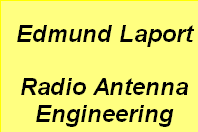


Antentop is FREE e-magazine devoted to Antennas and Amateur Radio an
Special page devoted to
Current Distribution in the A.L.C.

Custom Search
|
ANTENTOP-
03- 2003, # 004 |
Current
Distribution in the A.L.C.
|
||
|
|
|||
What is the truth?http://lists.contesting.com/_topband/2003-05/msg00044.html Tom,
W8JI on his web page http://www.w8ji.com/mobile_and_loaded_antenna.htm states: "The
modeled current distribution for 1-ampere applied at the base
(in 1-foot intervals) is: 1ft= 1.0031 Measuring the current
into and out of the loading coil with a small thermocouple RF
meter, I detect no difference This is in close agreement with
the model. " and "conclusion"... "Clearly
there is no basis to the claim current is high only in the first
few turns of an inductor, or that current tapers in relationship
to "electrical degrees". The most accurate way to state
the effect would be to say: "When the loading coil is short
and the capacitance of the antenna beyond the coil is reasonable
(in this case 3000 ohms Xc or less), there is an immeasurable
reduction in current in the coil." First, there
is a problem in his modeling with current increasing from the
base towards the coil. That should be the flag telling him that
2 + 2 is not sometimes 4.04. Second, EZNEC has no provision for
incorporating physical length of coil. It just considers LC parameters.
Roy Lewallen, W7EL, author of EZNEC and Richard Clark, KB7QHC
recommend workarounds to replace the coil with cylinder of similar
size or breaking the coil to number of physical segments with
appropriate inductances. W8JI "findings and measurements"
hardly |
reflect the reality. As
someone said, one measurement is better than thousands of theories.
The question is, how was W8JI measuring the current, and getting
more current than it was applied at the base?
Barry,
W9UCW among other arguments and explanations
wrote: "In our
measurements, we used long and short coils and the current taper
was was almost identical if the topmast capacitance was held the
same. If the "I think
your position (W8JI) is clear....that under the condx described,
current reduction in a loading coil can't, won't, never did, never
will happen. My Barry,
W9UCW was kind to provide proof in the form of some measured data
and photographs showing the antenna setup, loading coil and RF
ammeters installed at the top and bottom of the loading coil,
which could be reversed: "Here are some actual measurements
of current below and above loading coils. 92" mast, using a HI-Q coil
(openwound airdux, 2 1/2"d) with small thermocouple
type meters mounted on the insulated coil support. First for 40m,
moving the coil in the mast from base to center to top (with hat)
and reresonating. Base
--100ma below & 66ma above Center
--100ma below & 45ma above Top
--100ma below & 37ma above Then, same test but for 30m Base
--100ma below & 75ma above Center
--100ma below & 60ma above Top
--100ma below & 52ma above On a long, skinny 160 resonator with
25pf of top hat and whip, mounted on an 8' mast, I read 100ma
below and 65ma above the coil. Because of the constant claim that this
must be due to the fact that the coil is so big compared
to a wavelength, I measured the in and out current on
a TOROIDAL loading
coil used on a 20m mobile antenna. It was a 78" base mast
(including spring and mount) with a 38" top whip (including
12" of alum. tubing for adjustment). |
||
|
Page 55 |
|||
 |
 |
 |
 |
Just for Fun:

Powered byIP2Location.com
Thanks for your time!
Last Updated:
February 27, 2020 21:43




